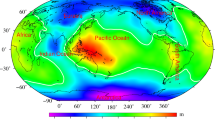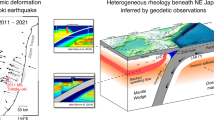Abstract
The effect of mantle viscosity structures on numerical simulations of geoid anomalies in the Ross Sea is investigated. Four relatively new S-wave seismic tomography models, SEMUCB_WM1, TX2019slab, S40RTS, and SEISGLOB2, are applied to convert seismic wave velocity anomalies into density anomalies. These density anomalies constitute the buoyancy-driven terms in mantle convection equations used to numerically simulate geoid anomalies corresponding to structures with different upper-to-lower mantle viscosity ratios. When the simulated geoid anomalies fit the observations best globally, the correlation coefficients between the geoid anomalies in the Ross Sea and the observed values are 0.56, 0.57, 0.57, and 0.46, respectively, for the four tomographic models. The best fits between the simulated geoid anomalies and observations in the Ross Sea area were obtained for upper-to-lower mantle viscosity ratios of 1:35, 1:45, 1:30, and 1:30 using the SEMUCB_WM1, TX2019slab, S40RTS, and SEISGLOB2, respectively. Within the range of the mantle viscosity structures selected for the simulation experiment, as the viscosity of the lower mantle gradually increases from the value at which the numerical results best fit the observations to the maximum value, the correlation coefficient between the simulated geoid anomalies and observations decreases faster for the Ross Sea area than on the global scale. We speculate that the lower mantle below the Ross Sea area may contain materials with lower viscosity than those in other mantle regions at the same depth.






Similar content being viewed by others
Change history
25 August 2022
A Correction to this paper has been published: https://doi.org/10.1007/s00024-022-03126-5
References
Adam, C., King, S. D., & Caddick, M. J. (2021). Mantle temperature and density anomalies: The influence of thermodynamic formulation, melt, and anelasticity. Physics of the Earth and Planetary Interiors, 319, 106772. https://doi.org/10.1016/j.pepi.2021.106772
Baes, M., Sobolev, S., Gerya, T., et al. (2021). Plate motion and plume-induced subduction initiation. Gondwana Research, 98, 277–288.
Brizzi, S., Zelst, I., Funiciello, F., et al. (2020). How sediment thickness influences subduction dynamics and seismicity. Journal of Geophysical Research: Solid Earth, 125, e2019JB018964.
Chaves, C. A. M., & Ussami, N. (2013). Modeling 3-D density distribution in the mantle from inversion of geoid anomalies: Application to the Yellowstone province. Journal of Geophysical Research: Solid Earth, 118, 6328–6351.
Cui, R., Fang, J., & Wang, Y. (2021). Study on the origin of geoid anomalies in the Ross Sea area. Chinese J. Geophys, 64(4), 1279–1290.
Dziewonski, A. (1984). Map** the lower mantle: Determination of lateral heterogeneity in P velocity up to degree and order 6. Journal of Geophysical Research, 89(B7), 5929–5952.
Forte, A. M., Peltier, W. R., & Dziewonski, A. M. (1991). Inferences of mantle viscosity from tectonic plate velocities. Geophysical Research Letters, 18(9), 1747–1750.
French, S. W., & Romanowicz, B. A. (2014). Whole-mantle radially anisotropic shear velocity structure from spectral-element waveform tomography. Geophysical Journal International, 199(3), 1303–1327.
Fu, R., Huang, J., & Liu, W. (1993). Seismic tomography: Internal heterogeneity of mantle and its geodynamical inferences. Acta Geophysica Sinica (in Chinese), 36(6), 740–752.
Ghosh, A., Becker, T. W., & Zhong, S. (2010). Effects of lateral viscosity variations on the geoid. Geophysical Research Letters, 37, L01301. https://doi.org/10.1029/2009GL040426
Ghosh, A., Thyagarajulu, G., & Steinberger, B. (2017). The importance of upper mantle heterogeneity in generating the Indian Ocean Geoid Low. Geophysical Research Letters, 44(19), 9707–9715.
Hager, B. H. (1984). Subducted slabs and the geoid constraints on mantle rheology and flow. Journal of Geophysical Research: Solid Earth, 89(B7), 6003–6015.
Hager, B. H., Clayton, R. W., Richards, M. A., et al. (1985). Lower mantle heterogeneity, dynamic topography and the geoid. Nature, 313(14), 541–545.
Hager, B., & O’Connell, R. (1981). A simple global model of plate dynamics and mantle convection. Journal of Geophysical Research, 86(B6), 4843–4867.
Hager, B. H., & Richards, M. A. (1989). Long-wavelength variations in Earth’s geoid: physical models and dynamical implications. Philosophical Transactions of the Royal Society of London Series A, 328(1599), 309–327.
Hsu, H. T. (1990). Geodesy and interior physical study of the Earth. Acta Geodaetica Et Cartographica Sinica, 19(3), 208–215.
Karato, S. (2008). Deformation of earth materials-an introduction to the rheology of solid earth. New York: Cambridge University Press.
King, S. D., Tech, V., & Biacksburg, V. (2007). Mantle downwellings and the fate of subducting slabs: constraints from seismology Geoid Topography, Geochemistry, and Petrology. Treatise on Geophysics, 7, 325–361.
Liu, X., & Currie, C. (2019). Influence of upper plate structure on flat-slab depth: Numerical modeling of subduction dynamics. Journal of Geophysical Research: Solid Earth, 124, 13150–13167.
Liu, X., & Zhong, S. (2016). Constraining mantle viscosity structure for a thermochemical mantle using the geoid observation. Geochemistry Geophysics Geosystems, 17(3), 895–913.
Lu, C., Grand, S. P., Lai, H., et al. (2019). TX2019slab: A new P and S tomography model incorporating subducting slabs. Journal of Geophysical Research: Solid Earth, 124, 11549–11567.
Moresi, L., & Lenardic, A. (1999). Three-dimensional mantle convection with continental crust: First-generation numerical simulations. Earth Interactions, 3(2), 1–4.
Nakao, A., Iwamori, H., Nakakuki, T., et al. (2018). Roles of hydrous lithospheric mantle in deep water transportation and subduction dynamics. Geophysical Research Letters, 45, 5336–5343.
Paulson, A., Zhong, S., & Wahr, J. (2007). Limitations on the inversion for mantle viscosity from postglacial rebound. Geophysical Journal International, 168, 1195–1209.
Pekeris, C. L. (1935). Thermal convection in the interior of the earth. Geophysical Journal International, 3, 343–367.
Richards, M., & Hager, B. (1984). Geoid anomalies in a dynamic earth. Journal of Geophysical Research, 89(B7), 5987–6002.
Spada, G., Sabadini, R., Yuen, D. A., & Ricard, Y. (1992). Effects on post-glacial rebound from the hard rheology in the transition zone. Geophysical Journal International, 109(3), 683–700.
Spasojevic, S., Gurnis, M., & Sutherland, R. (2010). Mantle upwellings above slab graveyards linked to the global geoid lows. Nature Geoscience, 3(6), 435–438.
Steinberger, B., & Holme, R. (2008). Mantle flow models with core-mantle boundary constraints and chemical heterogeneities in the lowermost mantle. Journal of Geophysical Research, 113, B05043. https://doi.org/10.1029/2007JB005080
Steinberger, B., Rathnayake, S., & Kendall, E. (2021). The Indian ocean geoid low at a plume-slab overpass. Tectonophysics, 817, 229037. https://doi.org/10.1002/ESSOAR.10506299.1
Sutherland, R., Spasojevic, S., & Gurnis, M. (2010). Mantle upwelling after Gondwana subduction death explains anomalous topography and subsidence histories of eastern New Zealand and West Antarctica. Goelogy, 38, 155–158.
Tosi, N., Cadek, O., & Martinec, Z. (2009). Subducted slabs and lateral viscosity variations: Effects on the long-wavelength geoid. Geophysical Journal International, 179, 813–826.
Wang, W., (2019). Characteristic of Geophysical fields and their implications of geological structure in Ross Sea, Antarctic [Ph.D. thesis]. Zhejiang University, Hangzhou, China.
Woodhouse, J. H., & Dziewonski, A. M. (1984). Map** the upper mantle three-dimensional modeling of earth structure by inversion of seismic waveforms. Journal of Geophysical Research Part b: Solid Earth, 89(7), 5953–5986.
Yamato, P., Husson, L., Braun, J., et al. (2009). Influence of surrounding plates on 3D subduction dynamics. Geophysical Research Letters, 36, L07303. https://doi.org/10.1029/2008GL036942
Yoshida, M. (2008). Core-mantle boundary topography estimated from numerical simulations of instantaneous mantle flow. Geochemistry, Geophysics, Geosystems, 9, Q07002. https://doi.org/10.1029/2008GC002008
Zhang, Q., Gao, J., Shen, Z., et al. (2017). Cenozoic tectonic characteristic and significance of the Adare Basin West Ross Sea. Acta Geoscientica Sinica, 38(4), 479–493.
Zhong, S., & Davies, G. F. (1999). Effects of plate and slab viscosities on the geoid. Earth and Planetary Science Letters, 170, 487–496.
Zhong, S., McNamara, A., Tan, E., et al. (2008). A benchmark study on mantle convection in a 3-D spherical shell using CitcomS. Geochemistry, Geophysics, Geosystems. https://doi.org/10.1029/2008gc002048
Zhong, S., Zuber, M. T., Moresi, L., et al. (2000). Role of temperature-dependent viscosity and surface plates in spherical shell models of mantle convection. Journal of Geophysical Research, 105, 11063–11082.
Zhong, S., Zhang, N., Li, Z., et al. (2007). Supercontinent cycles, true polar wander, and very long-wavelength mantle convection. Earth and Planetary Science Letters, 261, 551–564.
Acknowledgements
We thank the Global Seismology Research Group and IRIS (the Incorporated Research Institutions for Seismology) for supporting the data of tomography models. We also thank the editors and the two reviewers for their valuable comments and advice.
Funding
National Natural Science Foundation of China, 41874096, Jian Fang, 42192535, Jian Fang, State Key Laboratory of Geodesy and Earth’s Dynamics, S21L6401, Ronghua Cui, Key Laboratory of Geospace Environment and Geodesy, Ministry of Education, Wuhan University, 19-01-01, Ronghua Cui.
Author information
Authors and Affiliations
Corresponding author
Additional information
Publisher's Note
Springer Nature remains neutral with regard to jurisdictional claims in published maps and institutional affiliations.
The original online version of this article was revised: The given names and surnames of all authors were interchanged.
Rights and permissions
Springer Nature or its licensor holds exclusive rights to this article under a publishing agreement with the author(s) or other rightsholder(s); author self-archiving of the accepted manuscript version of this article is solely governed by the terms of such publishing agreement and applicable law.
About this article
Cite this article
Cui, R., Fang, J. & Wang, Y. Effect of Mantle Viscosity Structures on Simulations of Geoid Anomalies in the Ross Sea Area. Pure Appl. Geophys. 179, 2841–2850 (2022). https://doi.org/10.1007/s00024-022-03081-1
Received:
Revised:
Accepted:
Published:
Issue Date:
DOI: https://doi.org/10.1007/s00024-022-03081-1




